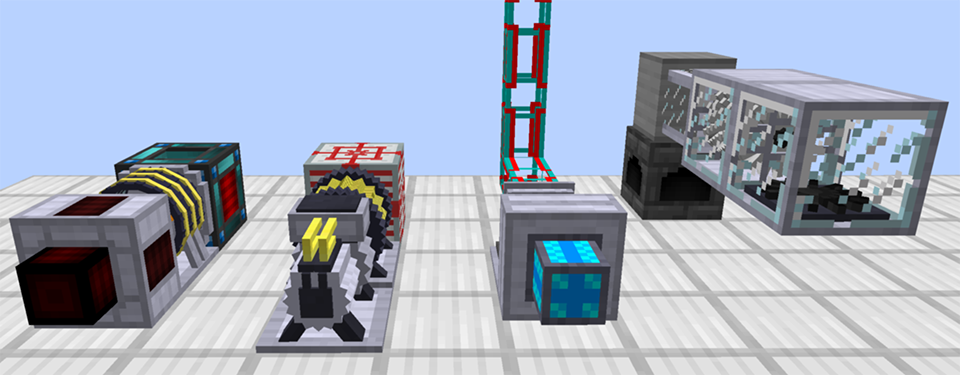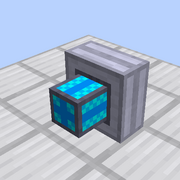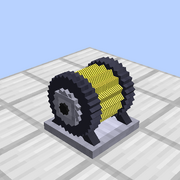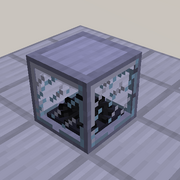RotaryCraft supports 5 other mod provided energy systems in Minecraft.
| Mod | Short name | Long name | Notes |
|---|---|---|---|
| Thermal Expansion | RF | Redstone Flux | Currently used by many different mods |
| BuildCraft | MJ | Minecraft Joule | Defunct. MJ has been deprecated in favor of RF |
| IndustrialCraft² | EU | Energy Unit | "One EU is most similar to the SI derived unit Joule" - IC² wiki |
| Electricraft | E * I = P | Volts * Ampere = Watt | Has RotaryCraft compatible machines of it's own. (Not detailed) |
| Railcraft | mPa / mB | Steam (pressue / milliBuckets) | |
| (v4+) PneumaticCraft | Bar / Psi | Compressed Air | Currently being implemented, uses BuildCraft converters |

The four machine types used to convert power. From left to right:
Thermal Expansion RF, Energy Cell -> Magnetostatic engine -> Rotational dynamo
IndustrialCraft² EU, MSFU -> Electric engine -> Electric generator
BuildCraft MJ (defunct), MJ transport pipes -> Pneumatic engine -> Air compressor
RailCraft Steam, Firebox+Steam boiler -> Liquid pipe -> Steam turbine -> Friction boiler
Converting to RotaryCraft power[]
RotaryCraft is a gated mod, meaning it expects the player to build machines in a certain order to progress upwards in the tech-tree. This applies to power generation from other mods as well.
Where most other mods provide a single machine (or no machine at all), simply allowing either power system to power their machines without limitations on how much power is converted. RotaryCraft's power conversion from other mods is heavily restricted and gated behind 6 tiers. This means that even if you have a massive energy generation capacity from other mods, like a bunch of nuclear reactors from IC² to give you enough EU to run 50 mass fabricators... It doesn't help you "jump start" RotaryCraft progression by plugging in that power system and spinning 50 extractors to quintuple your ore yield...
The conversion machines are somewhat expensive to build on their own and require upgrades to become useful consumers of the other mods power generation systems. Comparatively speaking, a tier 2 converter (supplied with both the "Redstone Cooling" and "Magnetic Coil" upgrades) is only as effective as two gasoline engines and cost much more in resources to build. Not to mention the specific requirements of the conversion machine...
You would be better off using RotaryCraft power generation to build yourself up to a certain tier and then use the conversion machines to supplement your power input in RotaryCraft as that would be cheaper. But technically speaking you can base your RotaryCraft power generation entirely on converted power, at a price.
Conversion Tiers[]
| Tier - Upgrade[1] | Output | Consumption | ||||||||
|---|---|---|---|---|---|---|---|---|---|---|
| Torque (Nm) | Speed (rad/s)[2] | Power[2] |
RF/t[3] |
MJ/t |
EU/t |
mB/t |
Bar/?[4] | LN2/s[5] | Efficiency | |
| 0 - No upgrade | 8 | 256 | 2.048 kW |
2 |
2 |
2 |
51 |
? | 2 | 90% |
| 1 - Redstone Cooling | 32 | 512 | 16.384 kW |
4 |
2 |
2 |
152 |
? | 4 | 82% |
| 2 - Magnetic Coil[6] | 128 | 1,024 | 131.072 kW |
31 |
4 |
8 |
458 |
? | 5 | 74% |
| 3 - Flux Conductance | 512 | 2,048 | 1.049 MW |
251 |
26 |
63 |
1,373 |
? | 8 | 66% |
| 4 - Thermal Stability | 2,048 | 4,096 | 8.389 MW |
2,118 |
213 |
530 |
4,114 |
? | 18 | 58% |
| 5 - Torsion Resistance | 8,192 | 8,192 | 67.109 MW |
17,888 |
1,790 |
4,473 |
12,288 |
? | 42 | 50% |
- ↑ Upgrades are craftable items that you apply by right clicking a placed engine. Each upgrade makes the engine 8 times as powerful. (torque * 4, rad/s * 2)
- ↑ 2.0 2.1 Max available, adjustable
- ↑ Note that the Magnetostatic engine requires certain RF currents per tier, see the section below on Thermal Expansion's mod specific machines.
- ↑ PneumaticCraft hasn't been implemented yet.
- ↑ Liquid Nitrogen, assuming full power with ambient temperature at 25 degrees. Note that the minimum consumption is 2 mB/s no matter what.
- ↑ Needs to be magnetized to at least 720 microTeslas in a Magnetizer.
Temperature requirements[]
All machines capable of converting mod power to rotarycraft shaft power have very steep temperature requirements. If the temperature of one of these machines ever exceeds 500 degrees, the machine will violently explode leaving nothing (no upgrades, no materials) but a hole behind it. The potential temperature increase significantly (assuming you use max speed) with each tier, as seen in the following table.
| With coolant | Without coolant | |||
|---|---|---|---|---|
| Tier | Deg/s | Total increase[1] | Deg/s | Total increase[1] |
| 0 | 0 | 0 | 6 | 96 |
| 1 | 1 | 16 | 18 | 288 |
| 2 | 2 | 32 | 52 | 832 (!)[2] |
| 3 | 4 | 64 | 145 | 2,320 (!)[2] |
| 4 | 10 | 160 | 407 | 6,512 (!)[2] |
| 5 | 25 | 400 | 1,149 | 18,384 (!)[2] |
At tier 2, to operate the machine at full power, you must supply liquid nitrogen or it will eventually explode. However, if you run a tier 2 converter at 256 rad/s you don't need coolant if your ambient temperature is consistently below 84 degrees. Coincidentally, this would produce 32 kW of power. Just enough (with a 1:4 gearbox) to power a refrigeration unit, to make coolant. However, the sustainability of such a scheme is something i would leave to you.
In addition to that, assuming an ambient temperature below -92 degrees (technically only possible in a specific biome) you can run a tier 2 engine at 512 rad/s for 64 kW of power without needing coolant.
Or, by using 4 cooling fins, you can also run a tier 2 engine at 512 rad/s in a default biome at the very top of the world (or better yet, in an icy biome) if the temperature stays below -28 degrees. But once again, this would be experimental at best and requires more resources... Why not just build a regular gasoline engine and be done with it? Doing it this way is just for those who for some reason don't want to make gasoline engines. (say, you want to use RotaryCraft machines in the "steam era" without actually using the RotaryCraft steam engine or have specific power needs.)
BE MINDFUL of "Hot" biomes. It is possible to overheat a tier 5 conversion machine if it's placed near bedrock, in a desert biome and exposed to sunlight even if you have an infinite supply of coolant! Not to mention the caveat of using these in the nether.
Thermal Expansion[]
Magnetostatic Engine[]
The magnetostatic engine functions much like the pneumatic engine. It accepts RF provided to it, and its output speed can be selected to choose the total power output.

A Magnetostatic Engine
| Input | Back (RF conduit or energy cell equivalent) |
|---|---|
| Angular Transducer output | RF/t consumption and shaft output |
| Tier 0 | 1 RF/t |
| Tier 1 | 3 RF/t |
| Tier 2 | 24 RF/t |
| Tier 3 | 187 RF/t |
| Tier 4 | 1,491 RF/t |
| Tier 5 | 11,925 RF/t |
As the above table shows, the magnetostatic engine requires a certain Redstone Flux packet size to operate. This also limits what kind of RF capable transmission system can be used to fuel the machine. For instance, using a Resonant Energy Cell simply isn't enough to feed a Tier 5 machine. One must use a conduit capable of storing more than 11925 RF, such as the RF transfer cable from ElectriCraft or some other mods storage medium, like the vibrant capacity bank from Ender IO etc.
Rotational Dynamo[]
The rotational dynamo converts RotaryCraft power into Redstone Flux.
Due to the limitations imposed by the internal magnetic fields, it can take a maximum of 1024 Nm of torque at a maximum of 8192 rad/s. Any excess, while not dangerous, will be wasted.

A Rotational Dynamo
| Input | Back |
|---|---|
| Orientation | Like ThermalExpansion Dynamos |
| Output | 1 RF/t per 5,628 Watts input. |
| Angular Transducer output | RF/t generated and shaft input |
BuildCraft[]
Pneumatic Engine[]
The pneumatic engine uses a turbine to convert pressurized air from BuildCraft conductive pipes into shaft power. Use its GUI to choose the speed output. Higher power outputs will require more air pressure (more MJ per tick).

A Pneumatic Engine
| Input | Back (Conductive pipe using Minecraft Joules) |
|---|---|
| Angular Transducer output | MJ/t consumption and shaft output |
Air Compressor[]
The air compressor converts shaft power into pressurized air, which can be carried out via conductive piping to BuildCraft machines. If given excessive amounts of power, it can and will explode. Violently.

An Air Compressor
| Input | Back. |
|---|---|
| Orientation | Like BuildCraft engines |
| Output | 1 MJ/t per 56,280 Watts input. |
| Angular Transducer output | MJ/t generated and shaft input |
If the pressure inside the air compressor is allowed to build up past 1,000 kPa then the air compressor will explode.
IndustrialCraft²[]
Electric Motor[]
The electric motor uses IC2 electrical power to produce shaft power. Use its GUI to choose the speed output. Higher power outputs will require more electrical power and a higher supply voltage.

An Electric Engine
| Input | Back (IC² compatible storage output or cable) |
|---|---|
| Angular Transducer output | EU/t consumption and shaft output |
Electric Generator[]
The electric generator takes in shaft power and produces IC2 electrical power at a rate of 22512 W/EU. The total power output as well as EU packet size scales with the amount of power going in.

An Electric Generator
| Input | Back. |
|---|---|
| Orientation | Front outputs EU. |
| Output | 1 EU/t per 22,512 Watts input. |
| Angular Transducer output | Shaft input (Use EU reader for EU/t generated) |
Railcraft[]
Steam Turbine[]
The steam turbine takes in steam from any pipe or tank behind it and generates shaft power. Use the GUI to select the power usage (and steam consumption).

A Steam Turbine
| Input | Back (liquid pipe or similar carrying steam) |
|---|---|
| Angular Transducer output | mB/t steam consumption and shaft output |
Friction Boiler[]
The friction boiler uses shaft power to heat water pumped into it. When boiled, the water can be drawn out the top of the boiler as steam. This machine has a warm-up period before which it will not make steam. Note that this machine can overheat and violently fail.

A Friction Boiler
| Input | Shaft power: Bottom. Water: Sides |
|---|---|
| Orientation | Top outputs Steam. |
| Output | 8,000 mB of steam per per 1,000 mB of water. |
| Angular Transducer output | Current temperature and shaft input |
Heating a friction boiler above 500 degrees will cause it to rupture and leave a hole in the world. No refunds.
There is an in depth calculation for how much steam is generated, the short version is that at 25 degrees (normal surface temperature in the default biome) you get 8 buckets of steam per roughly 10 seconds when you supply 65.536 kW of shaft power.
Boiling energy = 2260 kJ/kg * 1000 kg * 1000 J/kJ = 2,260,000,000 Ambient temperature = 25 Delta temperature = 100 - Ambient temperature Heating energy = 4.18 kJ/kgK * 1,000 kg * 1,000 J/kJ * dT K = 313,500,000 Total energy = Boiling energy + Heating energy Time to heat one bucket of water (in ticks) = Total Energy / power * 200
Tips and Tricks[]
Nothing to add at this time, most should be covered above.